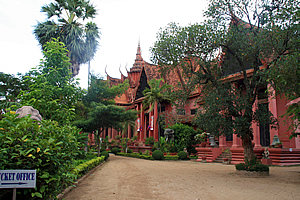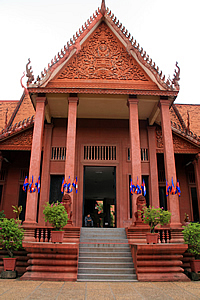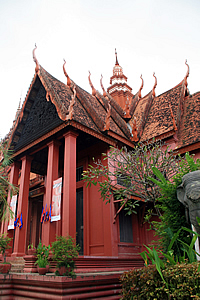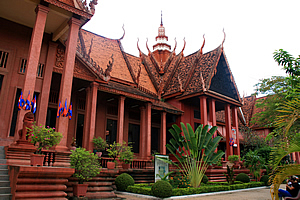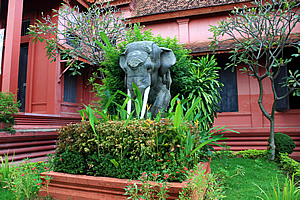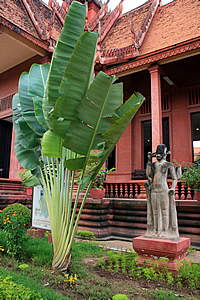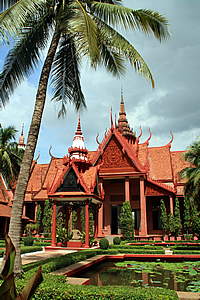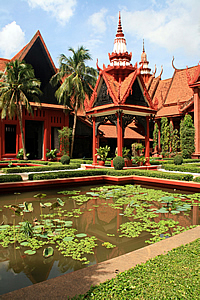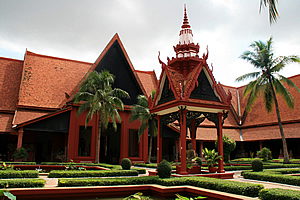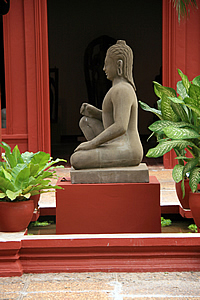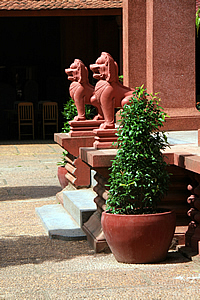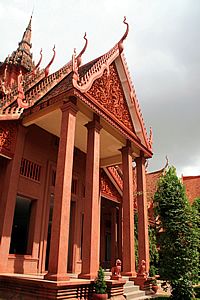--- Archive files ---
Home > Travels > Phnom Penh > 6 |
The most Beautiful Building in the World
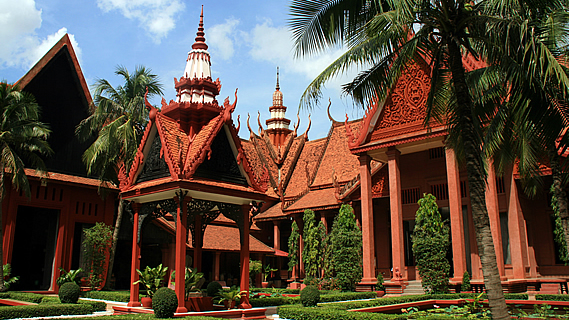
I HAD seen the mysterious building during my walk early this morning, glowing a bright salmon colour. Late yesterday afternoon when I had first arrived in Phnom Penh it stood as a very exotic silhouette against the bright sunset. From a distance it had been a very striking building, but that had not prepared me for just how stunning it really was.
Entrance to the National Museum |
The National Museum in Phnom Penh was built under George Grosslier who was the motivating force behind much of the revival in interest in traditional Khmer architecture. It was built between 1917 and 1920. There have been various renovations over the years as it was filled with some fourteen thousand artefacts.
It was operated by the French until Cambodia obtained independence in 1953. It has since continued operation under apart from between 1975 and 1979 during the reign of the Khmer Rouge when it was closed.
Main Entrance |
Upon reopening at the end of 1979, the building was in a serious state of disrepair with the roof rotten and home to the largest colony of bats ever known to occupy a building in the world. The gardens were badly overgrown and the building was deteriorating from neglect. Now it had been restored to one of the most amazing buildings in the world.
The National Museum provides a preservation of Khmer art and culture. It is also used for religious reasons, providing excellent collections of Buddhist and Hindu sculptures and inbuilt temples.
Having returned to the hotel from Phnom Wat, I crossed the road and entered the main gate paying the three dollar entrance fee. That seemed cheap to me, but keep in mind that would have been about half a week's wage for the average person here. Once inside the gate I saw the splendour of the building. It was painted an unusual brownish pink colour – a dark salmon perhaps. While I am normally not a fan of the colour pink, I was amazed just how well the colour fitted in with the contrasting bright green foliage that surrounded it, the palms and broadleaf trees attempting to hide it. Although the sky was overcast and gloomy overhead, the building had a warm inviting radiance about it.
Main Entrance |
Although the architecture was quite simple, perhaps even boxy, the flourishes on the roof were amazing. Tall windows graced the building as I walked towards its entrance. Numerous grey sculptures of elephants and other animals were scattered in the very formal bright green garden of exotic tropical plants. There was a sculpture of a large man with an elephant’s head, numerous cannons, several human deity sculptures and a couple of elephant sculptures surrounded my low hedges.
Then it clicked. I had been seeing those flourishes on most religious or royal buildings here in Cambodia, and they were all the same shape. Having just looked at the elephant statue and having seen the elephant at Phnom Wat eat bananas from my hands, I realised the weird shapes from the ridges of the roof pointing into the sky were representations of the raised trunks of elephants. They obviously hold a special place in the Cambodian culture, and they used the shapes as some form of protection or recognition, or perhaps just good luck. Elephants had traditionally been used in the construction of entire cities from the jungles. I’m sure much of the heavy labour of Phnom Penh had been done by elephants carving the city out of what had been dense jungle here well over a thousand years ago. These days the elephants had been replaced by modern construction machinery, taking away from the organic romance of the good old days. The raised trunks of the elephants on the roof corners were reminders of that past.
Outside of National Museum |
The walls of the brownish pink building appeared to have been made by large concrete blocks, though this was probably just rendering on the brick walls. The roof was held up my numerous plain square pillars towering up to the faces of the intricately carved gable faces of Buddhas surrounded by vegetation, again capturing the past relationships between the people and the natural environment. The roof was tiled with terracotta overlapping in multiple layers as I had seen throughout Cambodia, and also in Vietnam. The geometry here was perfect. There must have been some amazing mathematics going into the design of this building to make it so perfect. The layers of roofing were uneven, but followed a very close mathematically exponential pattern that I am familiar with in musical tonal theory.
Elephant statue outside main entrance |
The path I walked on was a creamy grey colour, blending in well with the vegetation. At the middle of the building, a grey staircase with twelve steps led up to the main entrance of the museum. The staircase was fairly narrow occupying the middle section in between pinkish brown steps. Two square pillars towered on either side of the grey steps. The four pillars were themselves plain apart from the adornment of two blue and red flags on each pillar mounted about three metres high with short poles rising at forty five degrees. A stone griffin in a darker shade of salmon to the rest of the building stood outside, partially obscured by a bright green pink flowering shrub in a pot on either side.
Outside main entrance |
Inside the main entrance the galleries looked quite dark, and I could just see a couple of people behind a large wooden desk just inside the door. The doorway was very plain, but it had a semicircular arch containing a series of round slats across the top above the lintel. The elegance of this building was stunningly unbelievable.
I walked through the huge entrance into a foyer area where a lady took my ticket. She said I couldn’t take photos inside, but outside in the courtyard was okay. The rendered walls inside the museum were rather dull sandstone grey and strikingly plain compared to the outside walls.
The gallery of historic artefacts extended in either direction. I turned right and started exploring them. Some were only a few hundred years old. Others were much older going back into history to about fourteen hundred years ago. They seemed to be arranged in artistic relevance as opposed to the seemingly more logical chronological order of time. Perhaps a different long standing cultural group was represented in each gallery.
Courtyard |
I entered a large room towards the end of the gallery. A lady sitting on a plastic chair at the entrance gave me an incense stick to burn and place on a small alter sitting at the far end of the room. The room carried a heavily musty savoury smell of cinnamon from numerous sticks of incense burnt. It was obviously some sort of Buddhist ritual. I took it to place it on the altar at the far end of the room, not knowing what that would mean. The sides of the room had display areas on either side cluttered with many dull ceramic artefacts. I looked at these quickly as I approached the altar. When I reached the end, I put the burning stick on incense in a small urn in front of the Buddha statue. Was I supposed to offer a prayer? Was I supposed to make a wish? I had no idea what to do, but obviously “when in Rome…”
I explored the large room with many ceramic bowl artefacts before leaving and continuing to explore the rest of the museum. By now I realised the building was a large square shape with a large square courtyard in the middle. The wings of the building were of an ideal width for museum galleries.
Courtyard |
Finally I reached the back of the museum where there were much larger artefacts, standing two to four metres high. I continued to work my way around the gallery until I was opposite the main entrance. From here a large open door led into the courtyard, so I left the mustiness of the inside of the museum to explore it. Now the outside of the building had been amazing, but the courtyard was even more stunning. Somehow the walls of the building viewed from the courtyard appeared to be longer than the walls viewed from outside the building at the front. I’m not sure why, perhaps it was the outside had been obscured with trees, and inside was a lot more under control with formal gardens.
The architecture of the building was incredible. Everything about the symmetry was perfect. It should have been too busy with all the layering of the roof and numerous columns, but it wasn’t busy at all. It was perfect. The courtyard had several large coconut palms in perfect condition. In fact the entire garden was absolutely perfect with not so much as a leaf out of place.
Courtyard |
The garden in the courtyard was the most amazing I had ever seen. The garden was formally laid out using the same pink colour pavers as the walls of the building. The courtyard was partitioned off into ponds with very healthy vegetation, large palm trees, and smaller foliage.
Within each corner of the courtyard was a low water pond with pink lilies on tall stalks surrounded by lily pads. The pond was a square shape with tapered edges jutting in as small squares, again utter primeval perfection. In between the lily pads the black water perfectly reflected the oriental towers penetrating into the sky towards the brooding cloud cover above.
Buddha |
A solitary lady was leaning over a pond diagonally opposite me wearing a white top and black trousers scooping excess vegetation out of the pond using a long scoop. Until then I thought I was here alone.
The paving on the ground was cream grey stones set into large cement blocks. Very short perfectly manicured hedges surrounded the paths, separating them from the larger vegetation. Much of the vegetation was compact broadleaf bushes, but there were some yellow flax like plants and flowering plants of all bright colours. There was also some red leafed vegetation, all in perfect balance.
A small Buddhist temple sat clandestine in the middle of the courtyard. The Buddha itself was cement grey and seemed to be a female form a bit overweight with longish hair and long earlobes. It was facing the front entrance of the main building where I had entered. There was a dieffenbachia native to the Amazon at each corner of the temple, and in front were ferns which seemed similar to the Australian birds nest fern.
Griffins |
Two dark pinkish brown griffins guarded the front entrance to the tiny temple. The roof above the Buddha was a perfect representation of the roof over the main building. There were four black gables with the same roof tiling and miniature elephant finials, going to a large white round apex towering above, representing the white round apex of the highest point of the main building at each of the four corners. The posts had black corner edgings elaborately carved. The temple was surrounded by almost a maze of the very low hedge, but off each corner of the temple was a perfectly rounded bush about fifty centimetres high. Stone dark salmon coloured griffins guarded the four entrances to the main building.
Around the edges of the garden, close to the main building, were large bulb shaped pots with small palm trees growing in them. There were square pots with sharp vegetation, and there were even a few matching ceramic seats.
Entrance from courtyard |
I had an absolute field day with photography there. A couple then came into the courtyard and he set up a tripod to photograph his girlfriend. They were both westerners who obviously knew about this great location.
Once photography in the courtyard was finished, I returned to the back of the building and continued working my way around exploring the artefacts. I passed numerous people offering incense to visitors to burn at the Buddhist altars. It was only just after then that I realised they expected payment. Too bad I thought. If they wanted payment they should have a sign to that effect, or they should even just tell me. Perhaps it was payment by donation only. I didn’t know whether they could speak English, and I dared not ask in case they would try to push for a sale.
I finally returned to the main entrance and left the national museum in awe of its beauty – I had never seen such a beautiful building before, and couldn’t imagine I’d ever see anything else this beautiful again.
<< Previous | Next >> |
|
||
About this Page
|
||
|
|
|
Where is Walkabout Jeff? |
|
|
|
|
What is happening in Walkabout Jeff's hometown?
|
|
|
|
|
Who is Walkabout Jeff?Any normal person's idea of going out involves going to the local pub for a drink with a few mates. Walkabout Jeff isn't normal.
|
|
|
|
|
